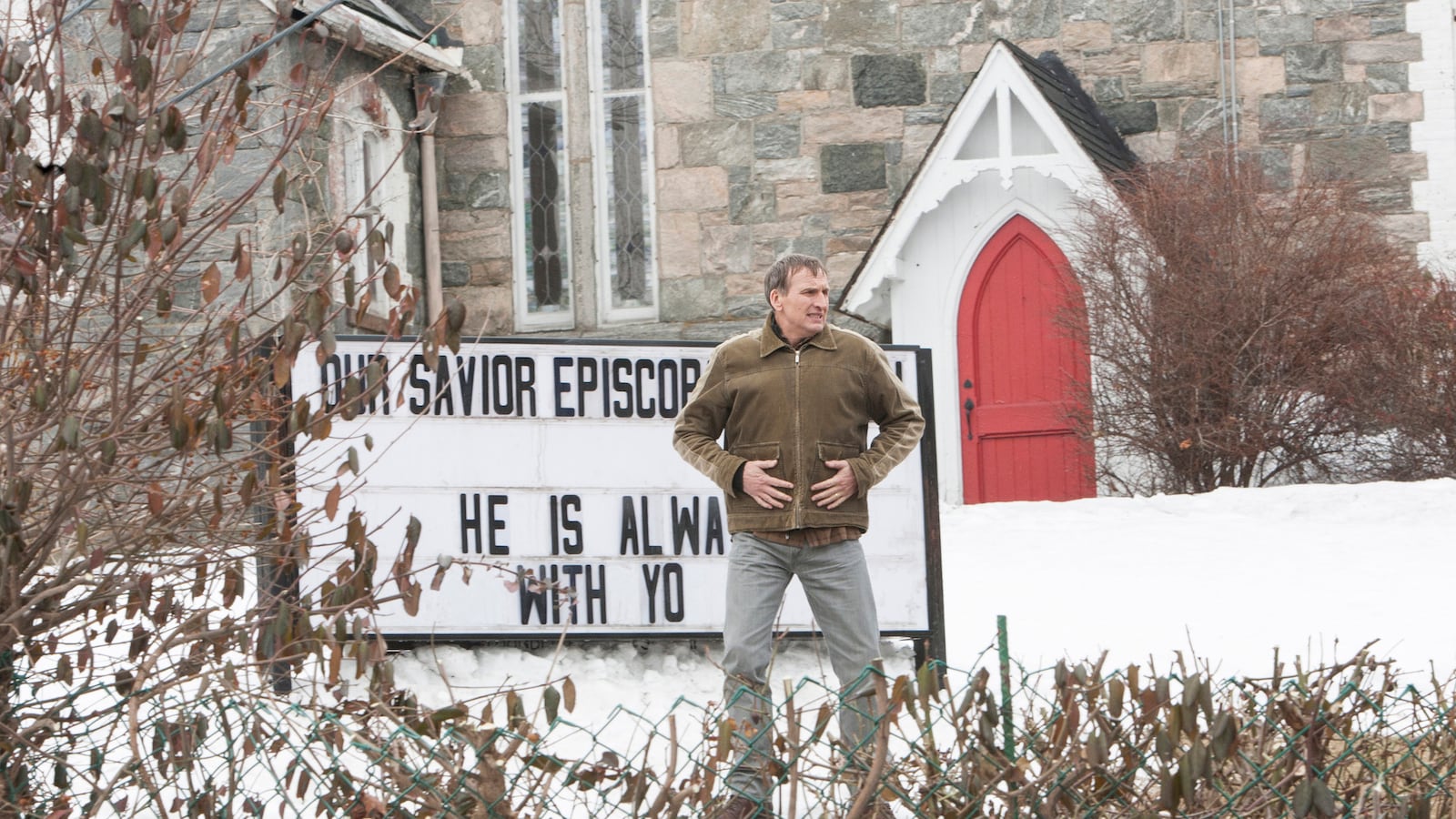In the opening moments of The Leftovers, the new apocalyptic drama that debuted last week on HBO, a crying baby vanishes into thin air from his car seat. As his mother frantically searches for her missing child, screaming his name over and over again, a few feet away a unmanned shopping cart rolls across a parking lot and a young boy, all alone, yells “Dad! Where’d you go? Dad!” A block away, a car without a driver speeds through a red light and crashes into oncoming traffic. Over the next few minutes, as the narrative moves to three years later, we learn that two percent of the world’s population—about 144 million people—disappeared that day in Rapture-esque fashion, an unexplained tragedy that befuddles scientists, theologians, pundits, and politicians, and leaves everyday people at a loss on how to move on.

While watching The Leftovers’ opening scene, I felt déjà vu, amazed at how closely the narrative resembled how I once imagined the end of the world would one day—in a twinkling of an eye—begin. Raised in a Baptist church and a firm believer in the Rapture—an event that many evangelical Christians believe will begin with the sound of a trumpet, climax with a heavenly sighting of Jesus Christ, and conclude with the mass disappearance of millions of people, souls that God deemed true believers and worthy of spending eternity in heaven—I spent the better part of 30 years believing, dreaming, hoping, and anticipating that, at any moment, Jesus would invade Earth like a thief in the night and I would vanish into a cumulus cloud with my savior. Believing in the Rapture never felt odd, mostly because nearly everybody I knew believed the exact same thing; in fact, my friends and I planned to disappear together and meet up on the other side.
Though believing in the Rapture seems to be a fading craze among Americans—even among Americans identifying as evangelicals, the Rapture has lost a bit of its spiritual thrill—the Rapture-ready faith is nowhere close to dying out in the United States. In fact, in 2011, the Pew Research Center found that 41 percent of “people in the United States believe that Jesus Christ will either definitely or probably return to Earth before 2050.” Come October, Hollywood is banking on those Rapture-believing Christians filling up theaters to see Nicolas Cage in Left Behind, a reboot of 2000’s Left Behind: The Movie that starred Kirk Cameron.
The only thing that might be crazier than 100 million-plus Americans believing in the Rapture and Hollywood catering films to fit their beliefs is the Rapture’s strange and surprisingly short history.
Believe it or not, the Rapture, as many evangelicals understand it today, is an idea that’s less than 200 years old, one part of an eschatology invented in the 1830s by John Nelson Darby, a British Bible teacher and devout member of the Plymouth Brethren. As a theologian, Darby constructed an entire Biblical interpretation known as Dispensationalism, an evangelical futurist expounding that, among other things, suggested that God’s relationship with humanity varied according to dispensations, or periods in history. According to Darby, God’s epic timetable—from Adam and Eve to the apocalyptic end—is split up into seven non-uniform eras. For instance, Darby’s first era—the dispensation of innocence—started with Adam and Eve and lasted only as long as the first biblical pair lived in the Garden of Eden. The second era—the dispensation of conscience—began right after God evicted Adam and Eve from the Garden and ended when Cain murdered Abel. Darby said the sixth era—the dispensation of grace—started with the crucifixion of Jesus and would not end until Jesus rescued all Christians from earth, making the way clear for the Great Tribulation—seven years of torment and pestilence—to begin.
Though Darby is credited for popularizing and theologizing the Rapture, taking one or two vague biblical references to Christ’s appearing and embellishing them into one grandiose premillennial exit, it’s unclear whether or not the Rapture was originally Darby’s idea. Many believe the Bible teacher stole, borrowed, or was inspired by Margaret MacDonald, a Scottish 15-year-old who, in 1830, received a vision from God. Or at least that’s what she believed. Others claimed MacDonald’s dreamlike message actually came from demons. Nonetheless, the prophetess’s first person account, published ten years later in Memoirs of James and George MacDonald, Of Port-Glasgow, details an event that sounds an awful lot like Darby’s Rapture: I felt this needed to be revealed, and that there was great darkness and error about it; but suddenly what it was burst upon me with a glorious light I saw it was just the Lord himself descending from Heaven with a shout, just the glorified man… Jesus wants his bride. His desire is toward us. He that shall come, will come, and will not tarry. MacDonald saw a lot that day, including gold candlesticks, the Kingdom of Heaven, and lots of violent judgment for the wicked. She even saw the prophet Elijah. Still, without Darby’s theological expounding, MacDonald’s Rapture would have likely died away.
Thirty years later, a Presbyterian minister named James Brookes from St. Louis, Missouri, became obsessed with Darby’s Biblical philosophies, so much so that the two met on at least a couple of occasions during Darby’s visits to the United States. Upon meeting his eschatological idol, Brookes became a chief American promoter of the premillennial message, using his Christian conferences and influence in the publishing world to spread the Darby gospel. Brookes’s most influential offering was his introduction of Darby’s theology to Cyrus Ingerson Scofield.
Scofield fell in love with Darby’s Dispensational God; not only did he write The Rightly Divided Word of God in 1888, Scofield eventually published his own King James Version “study Bible” in 1909, which was basically God’s Word with Dispensational and Rapture-readied footnotes, timelines, cross-referencing, and commentary. The Scofield Reference Bible sold millions of copies worldwide, and was one of the best selling books of the 20th century. That combined with William E. Blackstone’s multimillion copy seller Jesus is Coming, set the foundation for the Rapture and Dispensational theology to spread like wildfire among America’s believers. Dispensational-thinking evangelists like D. L. Moody and Billy Sunday also helped to deliver Darby’s soon-coming Jesus to millions.
During the 20th century, America’s Dispensational God turned into a multimillion dollar spiritual empire, a Christianized multi-faceted business that included books (fiction and non-fiction), pamphlets, prophesy conferences, radio and television shows, movies, trilogies, DVD series, and the careers of folks like Billy Graham, Pat Robertson, Jerry Falwell, Rick Warren, and a multitude of others. America’s Rapture craze didn’t simply affect the spiritual lives of its believers, the Dispensational worldview slowly seeped into nearly every aspect of the American lifestyle, including politics, science, education, foreign affairs, tourism, and media. Scofield once said that Christians shouldn’t be concerned with “the reformation of society… what Christ did not do, the Apostles did not do. Not one of them was a reformer.”
Few ideas have affected American culture and society more deeply than Darby’s thoughts on the Rapture, Dispensationalism, and the end of time. Though his theological understandings are seemingly on the decline among believers today, the power of belief should never be underestimated. A second coming of Rapture-minded evangelicalism is always one catastrophe, book, revival, or Nicolas Cage movie away.






